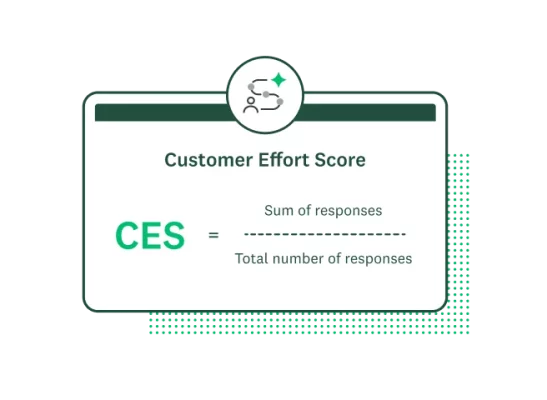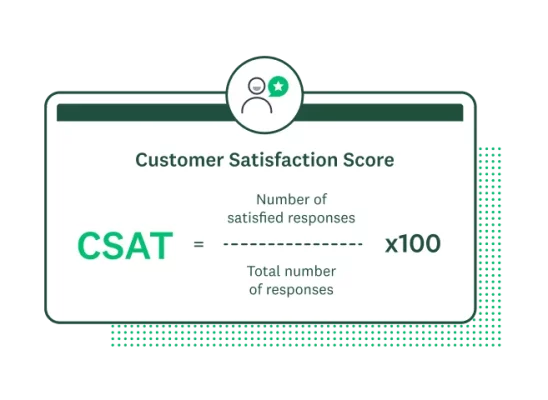9 key metrics for measuring customer experience

How loyal are your customers? How easy—or difficult—is it for them to meet their goals with your product or service? What was their most recent interaction with you like?
Understanding how customers feel about you from various perspectives is the only way to deliver the best possible experience to every user.
There are nine key metrics you can use to get different perspectives on your customer experience:
- Net Promoter Score® (NPS)
- Customer Effort Score (CES)
- Customer Satisfaction Score (CSAT)
- Customer lifetime value (CLV)
- Customer retention rate
- Customer churn rate
- Average response time
- Average resolution time (ART)
- Customer referral rate
Let’s dive into each of them.
1. Net Promoter Score® (NPS)
Net Promoter Score is the world’s leading metric for measuring customer loyalty. It comes from the question, “How likely would you be to recommend our company to a friend or colleague?” The answer choices fall under a scale from 0 (lowest) to 10 (highest).
Based on the responses, you can segment respondents into the following groups:
- Promoters (9 or 10 rating): Your happiest customers who are the most likely to buy more from you and refer your product/service to someone else.
- Passives (7 or 8 rating): Relatively satisfied with your product or service, but a subtle change in your business—whether it’s product/service or pricing-related—or an improvement from a rival could cause them to leave you.
- Detractors (0-6 rating): Your least happy customers, most likely to churn and tell others about their negative experiences with your business.
The metric is widely measured, so you can easily benchmark your score to see where you stand among industry competitors.
What NPS tells you
The NPS question allows you to determine whether or not your customers will say something positive about your brand. It gives you a holistic understanding of how customers feel. An increase in NPS suggests high customer satisfaction, which can lead to increased profitability and future growth.
How you can use NPS to improve customer loyalty
We recommend measuring the NPS every quarter. Doing so allows you to track overall progress over time and understand how specific individuals feel over the course of their time with you. You can make internal changes based on changing responses to improve the average customer experience.
If you have a large customer base, ask the NPS question to a rotating group of customers frequently (e.g. monthly cadence). This way, you can still survey each customer quarterly but receive a more frequent stream of feedback.
How to calculate NPS

Once all your responses from the NPS question come back and you’ve categorized each respondent as a promoter, passive, or detractor, you can use the following formula to get your score:
To calculate the percentage of promoters, find the total number of promoters, divide it by the total number of respondents, and then multiply the result by 100. You’d apply the same logic to calculate the percentage of detractors.
The result is an overall score that ranges from -100 (lowest) to +100 (highest). You can automatically calculate your score when you use the question in our Question Bank or ask it in one of our survey templates—like this one.
For more guidance on measuring customer experience with the NPS, check out our Net Promoter Score guide. It provides the framework for helping your team routinely measure, analyze, and take action on your NPS data.
2. The Customer Effort Score (CES)
Unlike the NPS, the Customer Effort Score asks for feedback on a single customer experience. More specifically, it focuses on understanding how easy or difficult it was to solve an issue with your team.
You can measure CES questions to gather insight into the customer journey following website visits, online checkouts, service sign-ups, sales interactions, or another customer-business touchpoint.
The CES survey asks customers to agree or disagree with the statement: “[Company name] made it easy for me to handle my issue.” You can include five answer choices that range from “Strongly agree” to “Strongly disagree.”
How to calculate Customer Effort Score

To calculate the score, first assign a numeric value to each choice. “Strongly agree” would receive a 1 rating, “Agree” would get a 2— all the way up to “Strongly disagree,” which would receive a 5. Then, you’d calculate your average score, where a lower average rating means—all else equal—a more effortless customer experience.
What CES tells you
Customer Effort Score tells you how your products and services perform in specific areas. It’s a simple measure that gives you direct insight into a recent customer experience with your company. As it is an easy field for your customer to respond to, you can get a great sense of your support teams' effectiveness with relative ease.
How you can use CES to improve customer experience
The CES metric allows you to understand the effort associated with specific customer interactions. By improving high-effort encounters, you offer your customer base a more successful customer experience. Resolving issues quickly and de-escalating frustrated customers can translate into a better business reputation.
For example, a CES survey could reveal that some customers must email several times about one specific issue. Knowing that, you can task support agents to include the needed information to solve a problem in the first email. Adaptive strategies like this will reduce the time it takes to manage a new support case.
By leveraging CES, you can also reduce the employee effort too. By empowering your customer success agents with all the tools and strategies they need to solve customer issues, they can rapidly attend to and solve any issues the customer has. CES can work to simultaneously improve the customer support experience while decreasing the effort it takes for employees to deliver fantastic service.
Note: You can automatically survey customers after conversations with support by integrating SurveyMonkey with your customer relationship management (CRM) tool. And you can embed your survey onto the purchase confirmation page to collect feedback on the ease of buying your product/service.
3. The Customer Satisfaction Score (CSAT)
The Customer Satisfaction Score measures overall customer satisfaction with products and services. You can use a CSAT score to measure various areas of satisfaction in your business rather than just one area.
The customer satisfaction survey asks, “How would you rate your experience with our [brand/product/service]?” with answer choices that range from very satisfied to very dissatisfied.
What CSAT tells you
On a scale of 1-10, 1-5, or 1-3, the CSAT score gives your business an idea of the overall satisfaction with an area of your business. As you can track multiple areas, like purchases, support, and shipping, you can compare overall business satisfaction segments against one another. While NPS focuses on whether or not a customer would recommend you, the CSAT is overall satisfaction with certain areas.
How you can use CSAT to improve customer experience
Like the Customer Effort Score, you can measure the CSAT score after a customer receives support from your team. Also, measuring it at regular, time-based intervals can be effective. That way, you can easily track your performance over time in a particular area. As you can customize the CSAT question, you can target specific areas of the customer experience that you want to improve.
You can focus on improving CSAT outliers to improve the customer journey across their entire experience with your business. However, it’s important to remember that the CSAT score doesn’t reflect long-term customer loyalty, instead focusing on particular experiences.
How to calculate CSAT

To get your CSAT score, take the number of respondents who mark themselves as satisfied (they either selected the answer choices “satisfied” or “very satisfied”) and divide it by the total number of respondents. Then, multiply the result by 100 so it’s converted into a percentage.
A higher percentage means a higher level of satisfaction. Like the customer effort score, you can measure the CSAT score after a customer receives support from your team or after receiving a product. The success of the CSAT metric depends on which question you ask.
Here are a range of CSAT questions you can use across various use cases:
- How satisfied are you with your recent experience on our website?
- How satisfied are you with our onboarding experience?
- What’s one thing we could do to improve your experience with [company]?
- How would you rate your satisfaction with your recent online purchase experience?
- Do you have any additional comments or feedback?
4. Customer lifetime value (CLV)
Customer lifetime value lets your business measure the expected revenue from a customer across their whole journey with your brand. It pulls data from every purchase a customer has made.
What CLV tells you
CLV tells your business how much revenue you have generated from a certain customer throughout their relationships with your company. It helps you determine a customer's long-term value, helping you make more effective budgetary decisions in marketing and customer acquisition.
How you can use CLV to improve customer experience
Calculating a customer’s lifetime value allows you to determine which customers are the most valuable to your business. You can segment your audience based on their overall lifetime value, creating new user segments for marketing and personalization. You can focus your retention techniques on customer segments with a high CLV, increasing the return of these efforts.
Depending on the marketing channels that each customer comes from, you may notice a strong positive correlation between a specific channel and a higher CLV. Using that data, you can adjust your marketing budget and approach to cultivate a larger audience of high CLV customers.
How to calculate CLV
The simplest way to calculate customer lifetime value is to determine the average purchase cost and multiply that by the number of purchases across a customer journey.
You can calculate CLV across individual customers, customer segments, marketing channels, or your entire company. For additional guidance on improving the customer experience based on customer interactions with your brand, check out our guide on customer satisfaction surveys.
Related: How to calculate the ROI of CX
5. Customer retention rate
Customer retention rate lets you measure how effective your company is at keeping your existing customers from churning. The higher your retention rate, the more likely you are to have a high customer satisfaction rate.
What customer retention rate tells you
Your customer retention rate tells you whether your customers are happy enough with your products and services to remain your customers. The higher your customer retention rate is, the more satisfied your customers are. On the other hand, a low retention rate could signal that your customers have issues with the quality of what you offer.
How you can use customer retention rate to improve customer experience
You can trace customer retention rates over certain time periods or through specific parts of the customer journey. It is more expensive to onboard new customers instead of increasing retention rates, making this a great area to concentrate on.
By working out where your customers are most likely to churn in the product lifecycle, you can improve their experience at that point. Points with a high churn rate are where you can improve the customer experience most.
How to calculate customer retention rate
To calculate your customer retention rate, you need to know the number of customers acquired during a certain period, the customers you had at the start, and the customers you have at the end. Once you have that information, to calculate your customer retention rate, you can use the following formula:
- [(Number of Customers at the End of a Period - Number of New Customers Acquired During the Period) / Number of Customers at the Start of the Period] x 100
Alternatively, you can divide the % of customers in one period against the % in the second period. This method will help you to determine your overall customer retention rate.
Be sure to take a look at our guide to improve customer loyalty and retention if you want to boost this metric.
6. Customer churn rate
Customer churn rate is the direct opposite of your customer retention rate. Instead of tracking how many customers remain loyal to your business, you work out how many have stopped paying for your products or services.
What customer churn rate tells you
The churn rate tells you how many customers have lost interest in your products or services. The most useful part of calculating your churn rate is doing so for different parts of your product lifecycle. You can trace the average churn rate across the customer journey to determine weak points in your services or products.
How you can use customer churn rate to improve customer experience
Once you know which parts of the customer journey most customers begin to churn, you can identify the reasons behind the churn. By improving the onboarding experience for new customers, you can reduce churn across the product lifecycle.
Focusing on reducing customer churn rate will lead you to address the core issues that your customers have with your services or products. As you fix these problems, the average customer experience will improve.
How to calculate customer churn rate
To calculate the churn rate formula, you first need to select a period of time. Record how many customers you had at the start of this period and the number of customers you lost. Here is the formula to calculate the customer churn rate:
- (Lost customers ÷ total customers at the start of time period) x 100
By dividing lost customers by the total number of customers at the start of your chosen period, then multiplying by 100, you’ll have a % churn rate. You can calculate the churn rate for different user segments or select distinct parts of the customer journey.
7. Average response time
When responding to customer inquiries, the longer you let a customer wait, the more likely they will feel frustrated. A low average response time is a marker of an effective customer support department.
What average response time tells you
The average response time will tell you how long it takes for your customer support to reply to a customer inquiry. You can measure the average response time across any customer-facing channel, like email, live chat, or even in-browser chatting. This metric is a good measure of how responsive your support teams are.
How you can use average response time to improve customer experience
You can trace the average response time of individual agents or of teams as a whole. If you establish clear benchmarks, you can train your support teams to strive for a certain response speed. If you respond to customers more quickly, they are more likely to have a positive support experience.
How to calculate average response time
To calculate the average response time of your support teams, add all of the response times together and then divide by the total number of inquiries. The lower the response time, the more efficient your team is at responding to inquiries.
Customer service doesn’t come easily to all companies. To put you on the right track, here are three tips on how to improve guest service scores.
8. Average resolution time (ART)
Average resolution time is the total amount of time it takes for a support agent to solve your customer’s issue. Unlike average response time, this is not only the first moment of contact but a measure of the entire process. For some problems, the average resolution time may be much more than others.
What average resolution time tells you
A short ART suggests that your support team efficiently solves customer problems. If you respond quickly to your customers and help them solve their issues, they’ll have a positive customer experience. If a support agent has a low average resolution time, it could suggest that they are efficient at their job, which your customers will love.
How you can use average resolution time to improve customer experience
You can trace the ART across different customer problems to determine where your customers need extra support. If a certain problem always frustrates your customers, producing support documentation they can access might decrease the likelihood of this problem occurring.
If your ART is high, you could provide additional training to your support team. If they are more confident with your software and know more about your products, they can close out inquiries in less time. Reducing your ART will result in an improved customer experience.
How to calculate average resolution time
You can calculate the average resolution time from when the customer opens the inquiry or your support agent's first response. The former will have higher ARTs but provide a figure more representative of the real customer experience.
To calculate ART, you should take the total time to resolve all requests and divide it by the number of requests.
The lower your ART, the better your customer support experience will be. Speaking of improving customer support, here are six tips to improve your team’s customer service skills.
9. Customer referral rate
The customer referral rate is similar to NPS as it gives you information about customer opinions of your brand. However, while NPS tells you how likely a customer is to refer your business to a friend, the customer referral rate shows how many customers are doing so. It’s a concrete metric that’s accuracy is a significant advantage over NPS.
What customer referral rate tells you
Your customer referral rate tells you how many of your new purchases come from customer referrals. It can range anywhere from 0-100% of purchases, with higher statistics showing that your customers refer your company more often.
Since customers typically recommend products and services they’ve had positive experiences with, customer referral rates can reflect overall customer satisfaction.
How you can use customer referral rate to improve customer experience
You can create customer referral rates for every product or service your organization offers. By tracking which services have higher referral rates, you can see where customers are deeming your services high-quality. If certain products have high or low referral rates, you can spot outliers in the customer experience.
Focus on improving the services or products with the lowest customer referral rates. The better each offering is, the more likely people are to recommend them to others. This metric will point you toward the areas of your business that you should improve, helping to increase the overall customer experience.
How to calculate customer referral rate
To calculate the customer referral rate, you need to know how many total sales you’ve had in any one period. Next, you need to determine how many sales came from a referral.
Divide the total number of sales from a referral by the total number of sales. Multiply this number by 100 to get your customer referral rate as a percentage.
If you had 500 sales in a month, and 50 of them came from referrals, you would have a 10% referral rate.
Understand the importance of customer experience
Measuring customer experience is the first step toward positively changing your customer journey.
Using any of these nine metrics for measuring customer experience gives you a more comprehensive understanding of your clients. You can use this improved understanding to take measures to make your clients happy and your bottom line even happier.
Whether it’s by using your CSAT score, NPS, or a mixture of different CX metrics, you can make changes based on your results to improve the customer experience. With this comprehensive guide, you’ll have all the tools you need to start to optimize your CX with concrete data. Using metrics will allow you to implement a Voice of the Customer (VoC) program and run a successful VoC program.
If you want to make collecting information a breeze, then SurveyMonkey is the platform for you. You’ll be boosting customer engagement and streamlining CX in no time!
Put customer experience at the heart of your business
Get the insights you need to delight and retain customers.
Net Promoter, Net Promoter Score, and NPS are trademarks of Satmetrix Systems, Inc., Bain & Company, Inc., and Fred Reichheld.
Discover more resources

Customer satisfaction survey templates
Explore our customer satisfaction survey templates to rapidly collect data, identify pain points, and improve your customer experience.

How to use Forms to enhance your survey experience
How do surveys and forms differ? Learn how to combine form data with survey feedback for seamless events and experiences.

Beyond CX: How SurveyMonkey + Salesforce turn feedback into revenue
SurveyMonkey + Salesforce turn feedback into revenue

Get the feedback you can act on with online evaluation forms
Unlock the power of feedback with SurveyMonkey's online evaluation forms. Start with our form builder today!